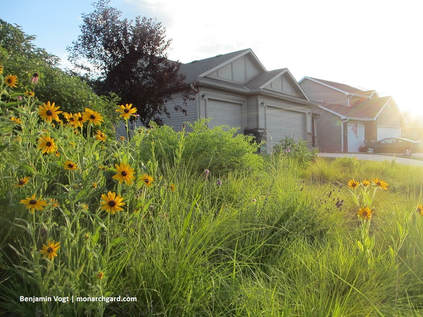1) Amending Soil
There is no perfect garden soil. Repeat. There is no perfect garden soil. There is no ideal to strive for -- and that ideal certainly is not rich-smelling, loamy, dark black soil that crumbles in your hand like cake. The typical thinking goes that if you have clay, sandy loam, or gravelly sand, then you MUST bring in lots of topsoil and compost to make it good, otherwise nothing will grow and you'll fail. You'll need to till that in, too, destroying soil structure and harming soil life. Sounds like a lot of work and money to me. Now, sure, there are situations when soil needs to be remediated (someone dumped gallons of oil, drainage issues need to be fixed), but buying bags of topsoil at big store x or y is not the answer to successful gardening. Researching what plants will do well in the conditions you have is the answer. Right plant, right place. Let's say you "amend" the soil one foot down, what happens when the plant's roots reach the native soil? It freaks out. It might decide to stay in the babied soil, never fully establishing, and never becoming drought tolerant or resilient because it's constantly in a state of being pampered. Which brings us to....
2) Mulch Mulch Mulch
Wood mulch also keeps plants in a state of perpetual establishment. Commonly we'll place a flower here, than 2 feet away another flower, etc until what we have are large gaps between plants -- gaps that don't exist in nature. Those gaps will need to be mulched every year or two because, as we all know, bare soil invites erosion, weed seedlings, etc. Or you could simply use more plants, and layer those plants, letting them do the work of not only amending soil for free over time as their roots move into the soil, but also out competing weed seedlings and shading the soil, thus conserving soil moisture. Mulch does help new trees establish, but maybe you could also just plant a thick, layered garden under the tree's drip line. No more mulch. No more spreading mulch. No more carrying mulch. No more buying mulch. Use your mulch allowance on more plants and make the long term investment for beauty, resilience, and wildlife habitat.
Before planting it's smart to get a soil test done -- in the very least it will tell you pH, organic matter percentage, and other nutrient levels. Now, contrary to conventional wisdom, these numbers aren't necessarily here to tell you what to add to "improve" the soil. No, for you mavericks these numbers are here to tell you what plants to match to the site. Doing this will greatly improve your chances of long term success. Why keep adding fertilizers year after year to maintain a plant's life support when clearly it doesn't like where it is? Yank it out and find something that doesn't tug at your purse strings. Besides, that fertilizer is produced with intensive industrial processes that contribute to climate change and pollution, and when they run off our landscapes they cause real problems for waterways (looking at you, commercials that insist on 4 lawn fertilizer applications a year -- two is plenty, unless the company needs to move more product).
Do gardens require work? You bet. They always will, like replacing and adding plants, because we're putting in something that wasn't here on its own. But there's gardening nature's way -- matching plants with the site, creating self-supporting plant communities, fostering biodiversity -- and there's the other way which keeps us from getting in tune with our local environment by forcing in costly management.
If you want to learn more about how to research the right plants for your landscape, and to design a more sustainable / low maintenance space, try this handy online class on starting your native plant garden. You'll discover the most informative websites and books, strategies for research and plant lists, and be walked through a sample design for a small pollinator garden.



 RSS Feed
RSS Feed

